Introduction, Package and Contents
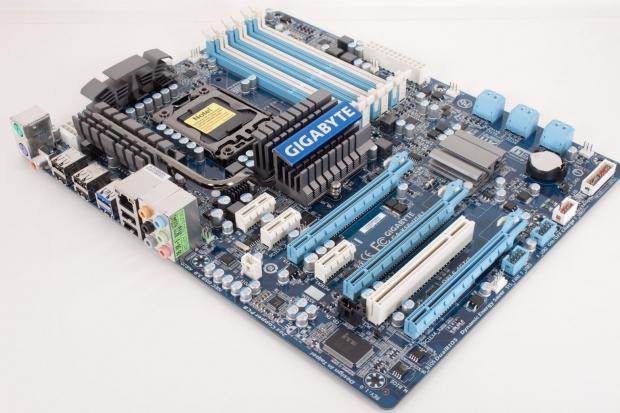
Introduction
With all the news about the P67, the B2 or B3 stepping and now Z68, there is still room for the tried and true X58 chipset. This time on our bench is a mid-range board from GIGABYTE - we have the X58-USB3.
The X58-USB3 leaves off the SATA 3.0, but keeps the USB 3.0. You also still get the usual SLI and Crossfire support and all for the fairly low price of $179.99 at Newegg at the time of writing. This is not bad at all to enter the world of triple channel RAM and the upper end Core i7 CPUs!
So let's take a look at this board and find out what kind of performance you can get for about $180.
Package and Contents
The box the X58-USB3 comes in looks much like all of the others on the market from GIGABYTE. The front has some of the typical imagery that GB uses including the 333 logo, the on/off charge logo and others.
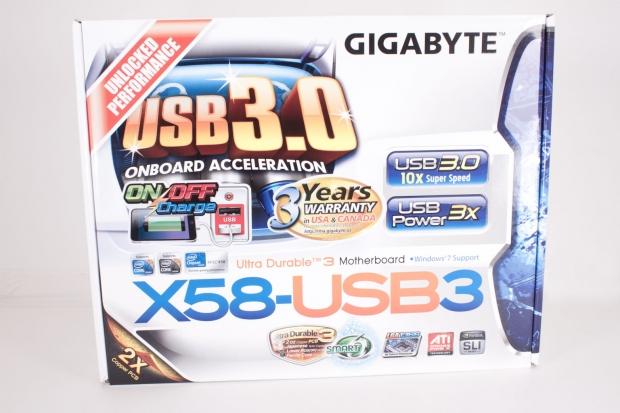
The back continues the trend with a little more detail that the front shows. One of the prominent features that GB wants to show off is the Dynamic Energy saver and the Smart 6 Suite of applications.
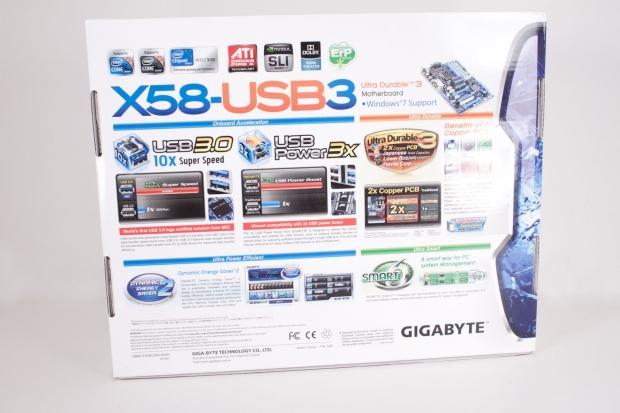
The loot in the box is in line with the price, but then again, what would you expect?
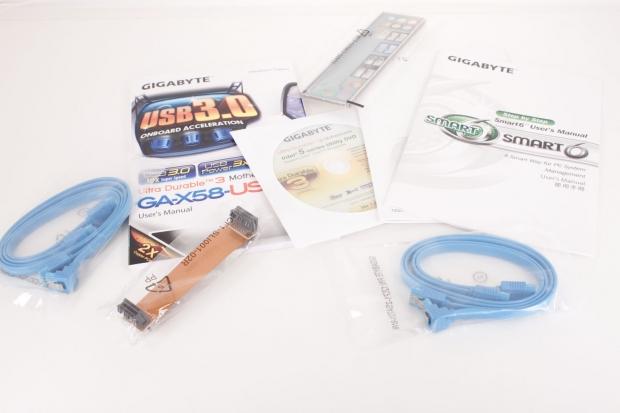
The Motherboard
The Board

The X58-USB3 is a clean board. This is primarily due to its simplistic design. As it is not loaded down with extras, the layout can be spacious and offer more room for components.
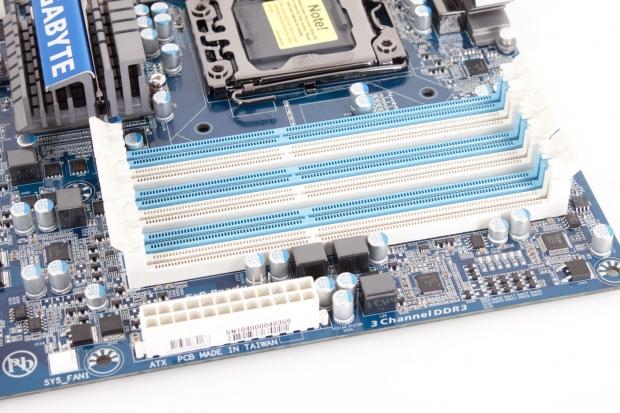
Of course, there are still some areas that are going to be a little cramped just by their nature. These are areas like the six RAM slots for the Triple Channel memory love you want. The CPU socket area is clean and very sparse. I mean it is very light on components; this could have a detrimental effect on overclocking if things are not setup right, though.
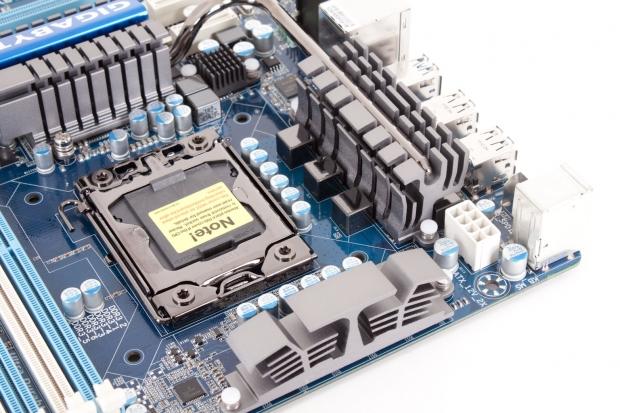
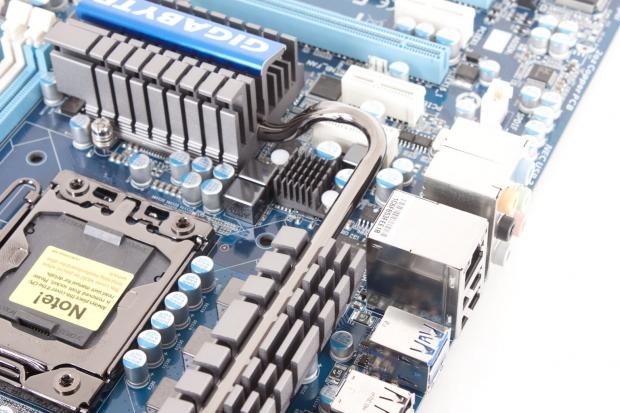
The cooling for all this is very beefy for the small number of power regulators on the board.
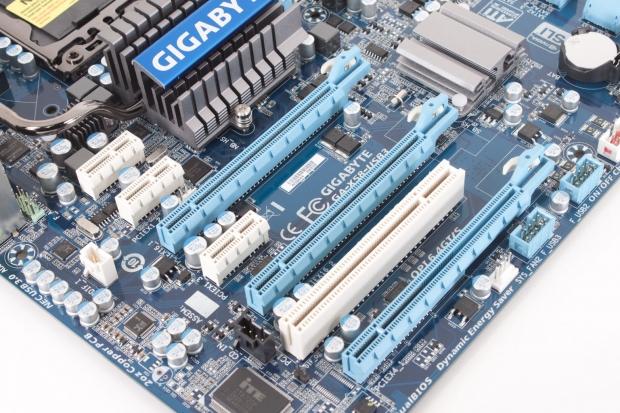
The peripheral slots are more than adequate. You have room for dual x16 SLI or Crossfire with an extra x4 slot thrown in for three-way Crossfire. You also get three x1 slots for good measure and a single PCI slot for those of you that still have those devices.
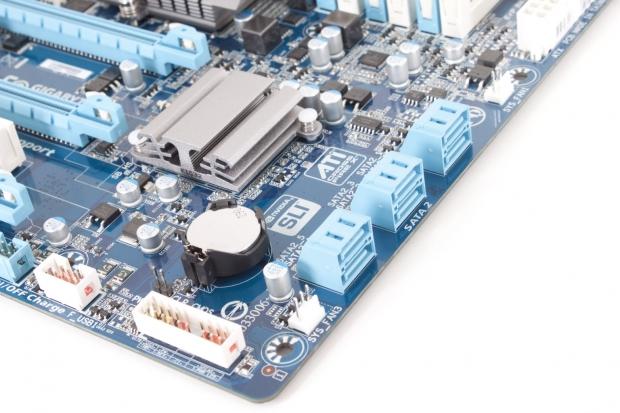
Flipping the board around, we get a look at the SATA ports. The X58-USB3 lacks something that people are expecting more often these days. There are no SATA 3.0 ports at all. You get six full SATA II ports (including GB's XHD) and that is it.
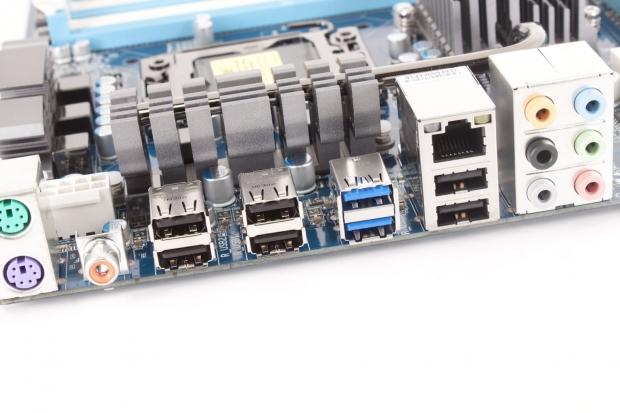
The I/O ports are not bad at all. You get six USB 2.0 ports, two USB 3.0 ports, two real PS/2 ports (one for mouse and one for keyboard), plus the usual audio ports. The X58-USB3 is a nice board; it is clean, well-built and has some well laid out tracing. Now we need to take a look and see if this design can perform or not.
BIOS and Overclocking
BIOS
The X58-USB3 has the same BIOS that we all have come to love from GIGABYTE. For the overclocker you will want to start off in the MIT pages. MIT for those of you that do not know stands for Motherboard Intelligent Tweaker.
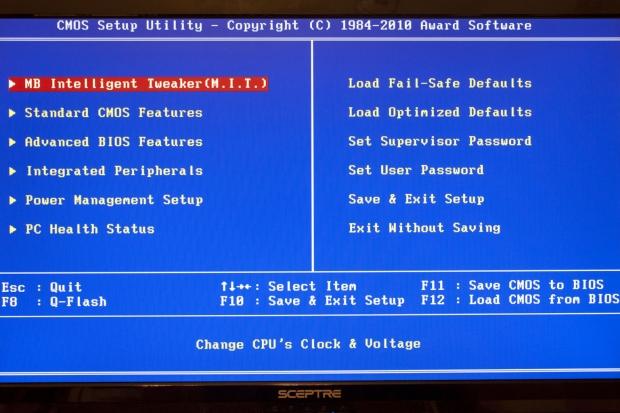
GB has broken the major functions down into separate pages. On one hand this makes things easy to navigate, while on the other you have to visit multiple places just to get things done.
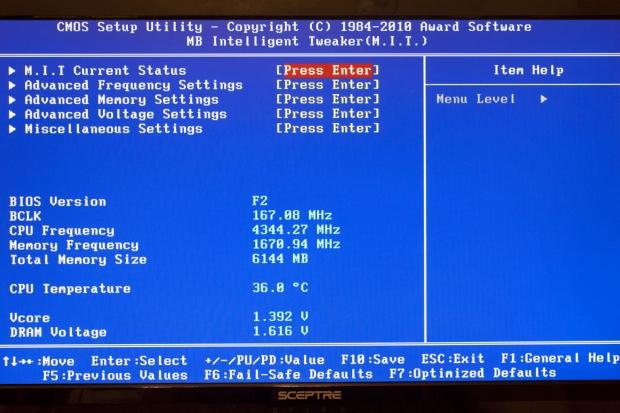
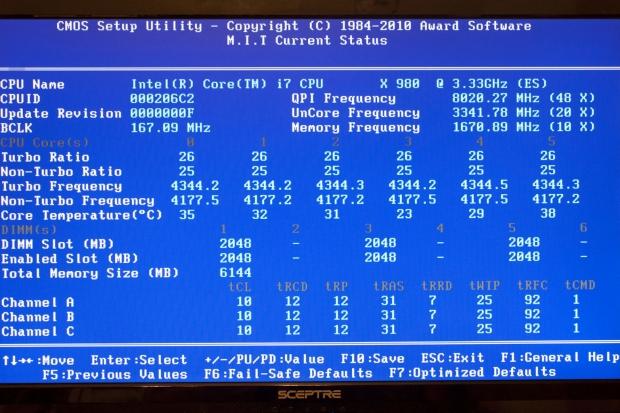
The Advanced Frequency Page is well laid out and easy to move around. It does include some settings that are available on a few other pages, but that is ok as it prevents you from having to hunt around for all of the basic OC tools.
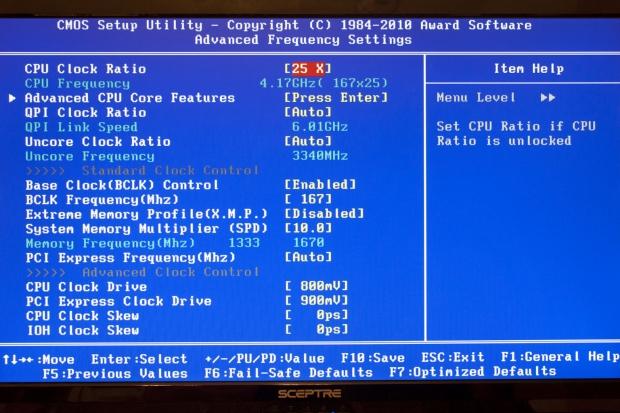
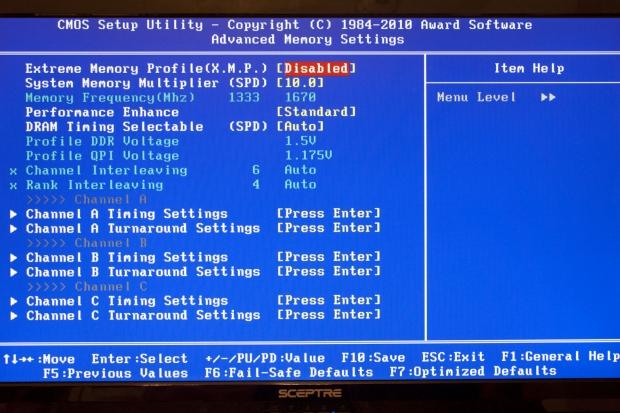
Here we find one of those settings that is in multiple places. The memory multiplier is here as well as in the Advanced Frequency page. No big deal as any changes made here are reflected on the other.
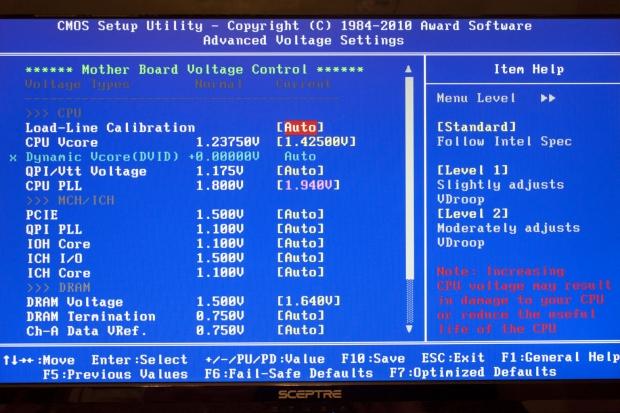
The voltage page is pretty simple, nothing unusual here...
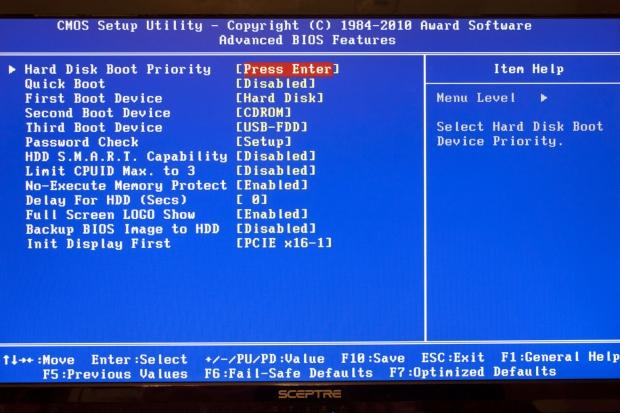
The rest of the BIOS is fairly typical for an X58 board.
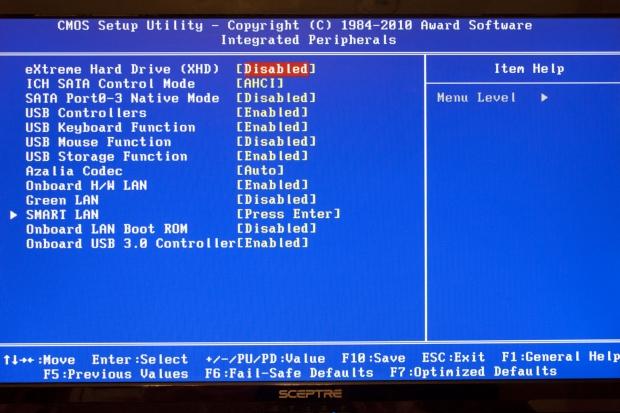
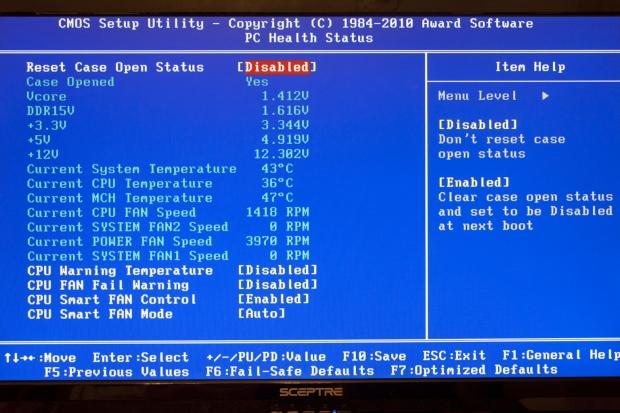
Even the PC Health page is not much different.
Overclocking
When I first took a look at the power regulation on the X58-USB3, I was concerned that I would run into some issues pushing the 980X CPU that I use for testing. After all, the limited voltage regulators, chokes and other items usually associated with good voltage regulation were in short supply. However, I was pleasantly surprised at how well this board overclocked; I found that I was able to push pretty hard and was able to hit a high of 4.343 GHZ (167x26).
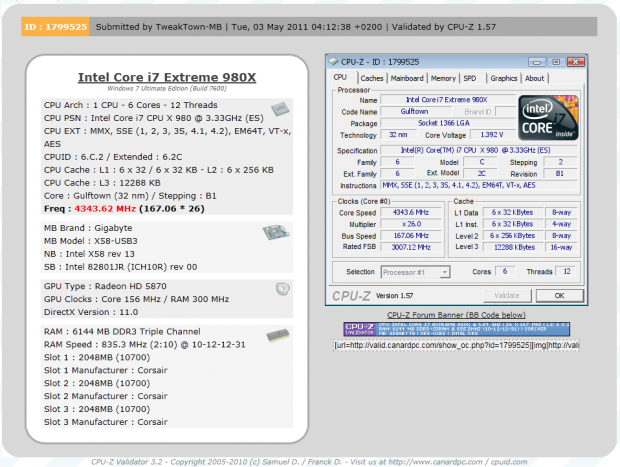
You can see the CPUz validation here.
EasyTune 6
We have talked about this overclocking/monitoring software on multiple occasions. It is functional and has some nice add-on features, but not many changes from install to install. We will cover some of the highlights and let the pictures do the rest of the talking.
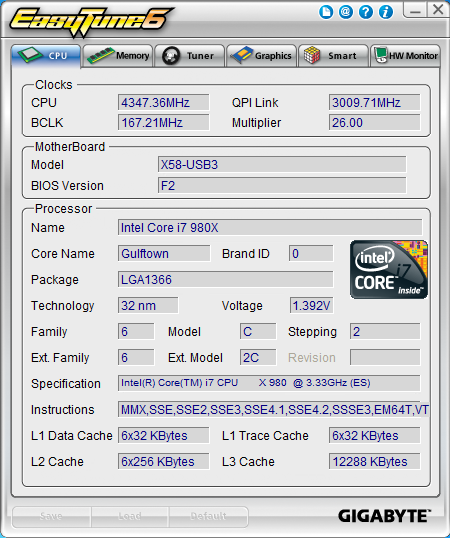
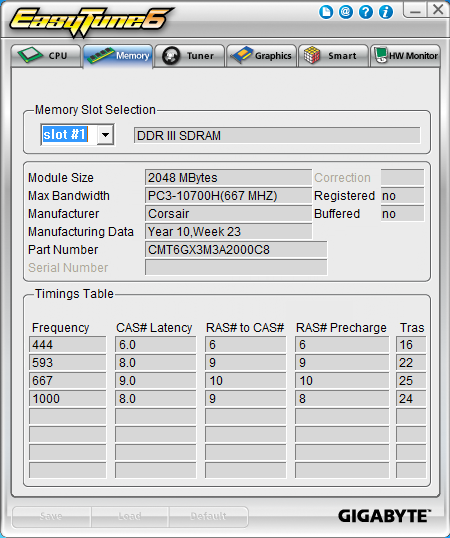
The Two CPU-Z like pages are nice to get a quick look at what you are getting for overclock speeds, but if you are serious you are still going to end up using CPU-Z in the end.
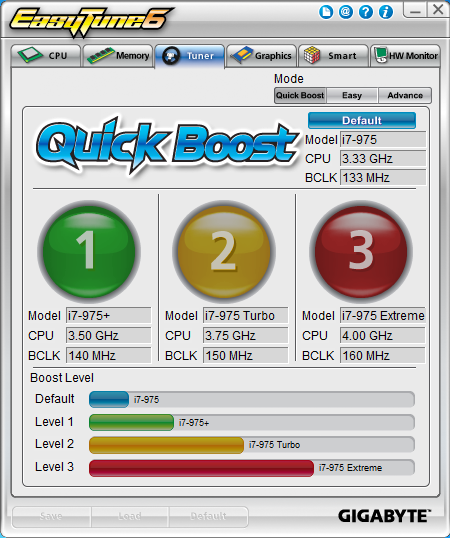
The Tuner pages have some interesting features even for those that might be very new to overclocking.
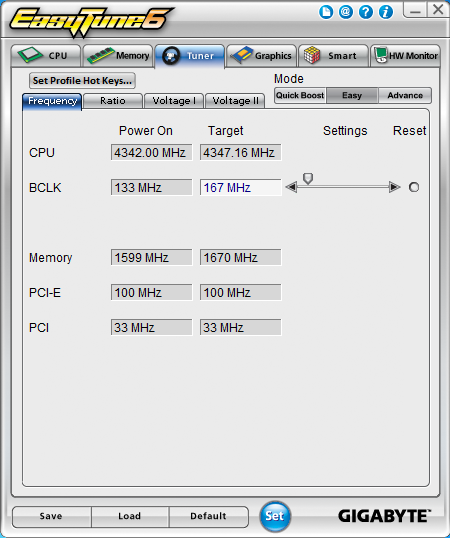
GB has included tools for everyone from beginner to expert.
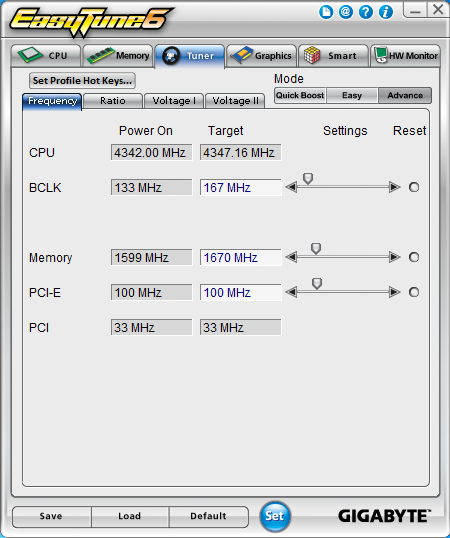
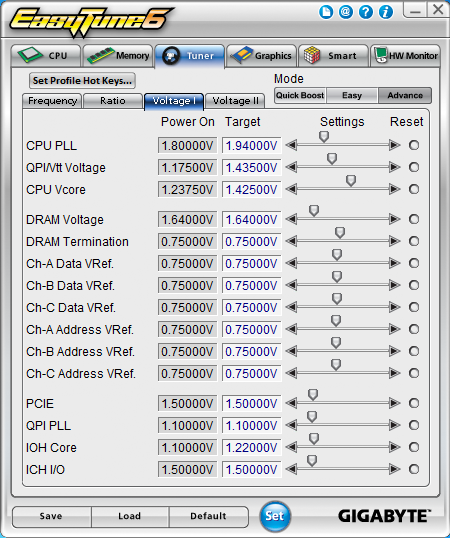
You even have the option to tweak your GPU (at least most of the time).
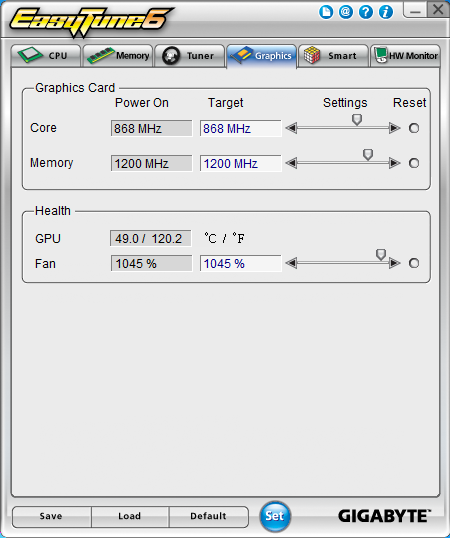
You also have a few options to adjust/monitor fan profiles along with temperatures and voltages.
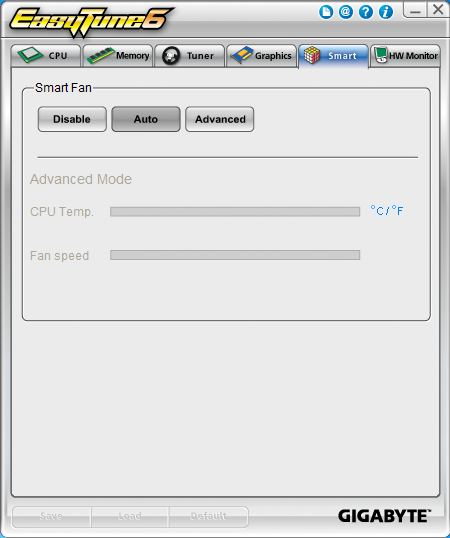
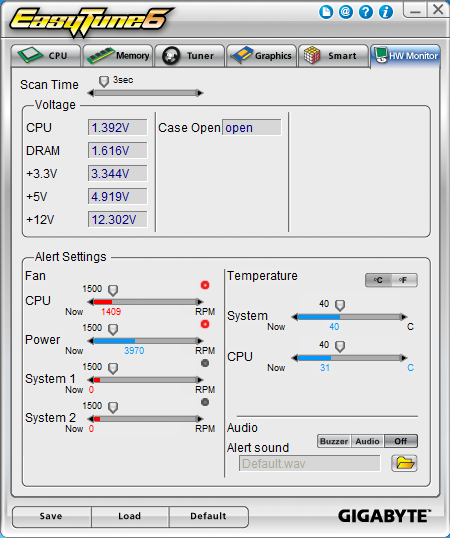
As all overclocking results are dependent on the hardware you use, your results may vary. Results of our overclocking tests are included in the performance section with the stock scores.
Important Editor Note: Our maximum overclocking result is the best result we managed in our limited time of testing the motherboard. Due to time constraints we weren't able to tweak the motherboard to the absolute maximum and find the highest possible FSB, as this could take days to find properly. We do however spend at least a few hours overclocking every motherboard to try and find the highest possible overclock in that time frame. You may or may not be able to overclock higher if you spend more time tweaking or as new BIOS updates are released. "Burn-in" time might also come into play if you believe in that.
Test System Setup and Comments
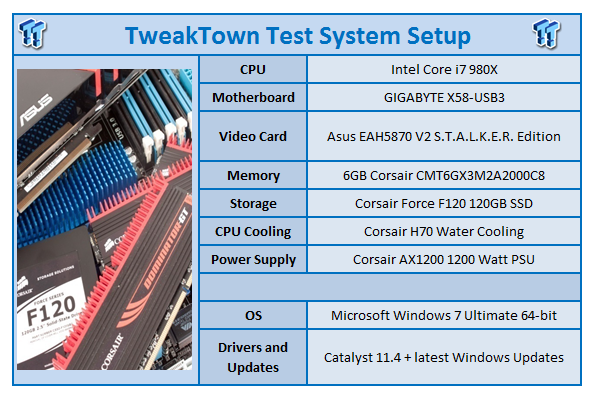
We would like to thank the following companies for supplying and supporting us with our test system hardware and equipment: GIGABYTE, ASUS, Intel, Corsair and Sceptre.
The setup of our test system this time was...well... it was as simple as all of the other times. In fact, I have a feeling that even as much effort (not much at all) as we put into building this review setup on our open test bench, you will have even less problems when you build this out in a case.
The software/driver install was a snap and we found that the utilities were installed at the end of the driver install with a simple prompt. This meant that we had all the fun toys like EasyTune6, DynamicEnergy Saver2 and of course the ever popular (for more mainstream and consumer boards) Smart Suite 6.
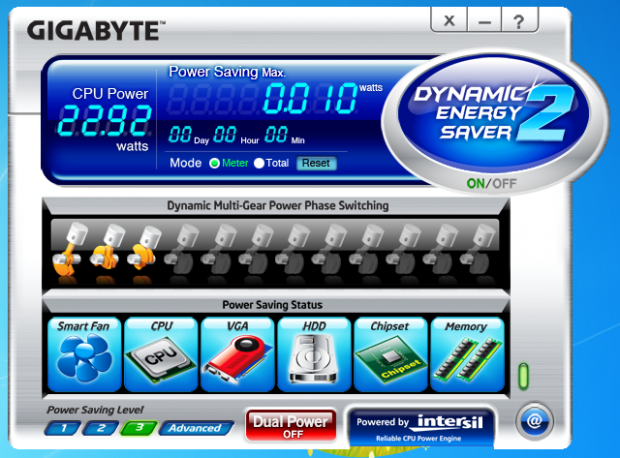

Synthetic Tests - Part I
With any system you will want to see a combination of synthetic testing and real-world. Synthetics give you a static, easily repeatable testing method that can be compared across multiple platforms. For our synthetic tests we use Finalwire's AIDA64, Sisoft Sandra, Futuremark's 3DMark Vantage and PCMark Vantage, Cinebench as well as HyperPi. Each of these covers a different aspect of performance or a different angle of a certain type of performance.
Memory Bandwidth
Memory is a big part of current system performance. In most systems slow or flakey memory performance will impact almost every type of application you run. To test memory we use a combination of Sisoft Sandra, AIDA64 and HyperPi 0.99.
Sisoft Sandra
Version and / or Patch Used: 2011
Developer Homepage: http://www.sisoftware.net
Product Homepage: http://www.sisoftware.net
Buy It Here
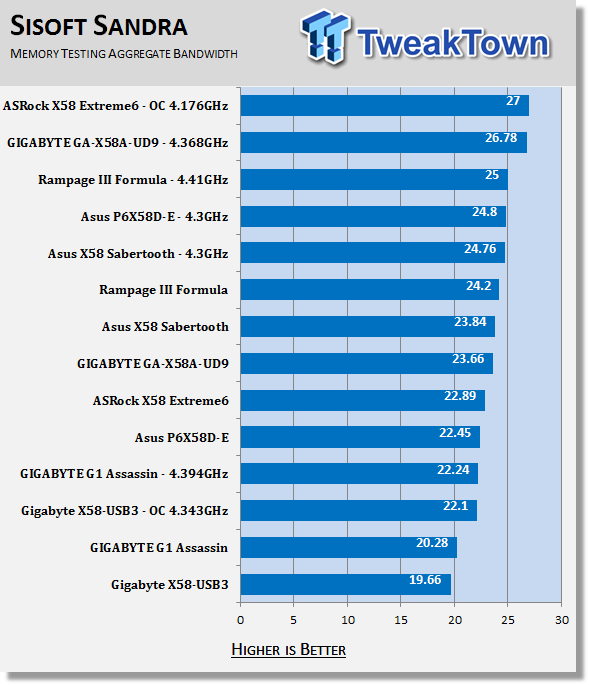
Ok, so memory performance is not top notch. We find the X58-USB3 at the bottom of the list at stock and almost at the bottom for overclocked performance. This will probably show up again in later testing unless we have some outstanding HDD performance to balance things out.
AIDA64
Version and / or Patch Used: 1.00.1035BETA
Developer Homepage: http://www.aida64.com
Product Homepage: http://www.AIDA64.com
Buy It Here
Replacing Everest in our labs is AIDA64. This new testing suite is from the core development team from Lavalys and continues that tradition. The guys have thrown in better support for multithreaded CPUs as well as full 64 bit support. We use this to test memory and HDDs for now, but may find ourselves opening this up to other areas of the motherboard.
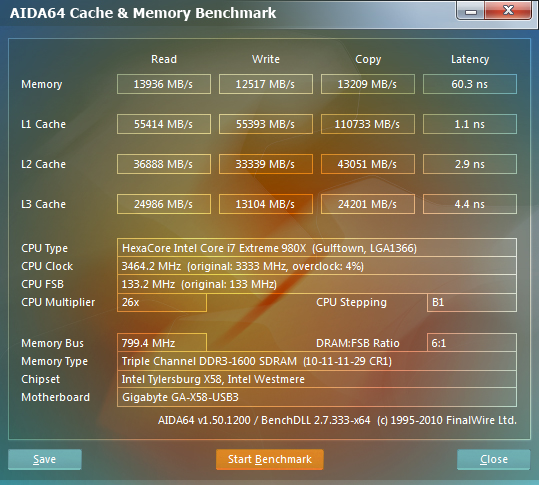
Stock Memory Performance
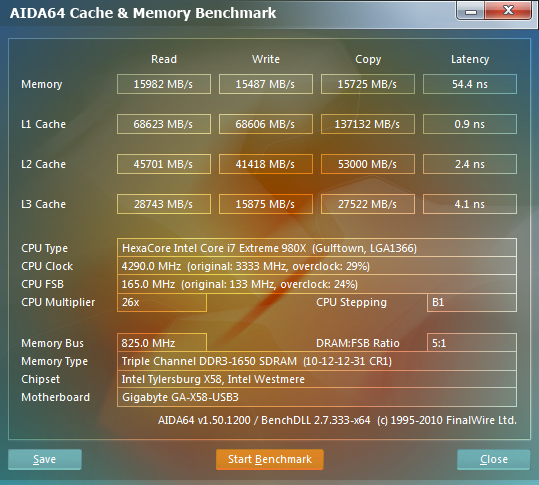
Overclocked Memory Performance
Looks like we could have some latency and base read issues here. However, the good news is that some of this can be fixed with updated BIOSes. So we have a feeling these numbers will improve over time.
HyperPi 0.99
Version and / or Patch Used: 0.99
Developer Homepage: www.virgilioborges.com.br
Product Homepage: www.virgilioborges.com.br
Download It Here
HyperPi is a front end for SuperPi that allows for multiple concurrent instances of SuperPi to be run on each core recognized by the system. It is very dependent on CPU to memory to HDD speed. The faster these components, the faster it is able to figure out the number Pi to the selected length.
For our testing we use the 32M run. This means that each of the four physical and four logical cores for the i7 and the four physical cores of the i5 is trying to calculate the number Pi out to 32 million decimal places. Each "run" is a comparative to ensure accuracy and any stability or performance issues in the loop mentioned above will cause errors in calculation.
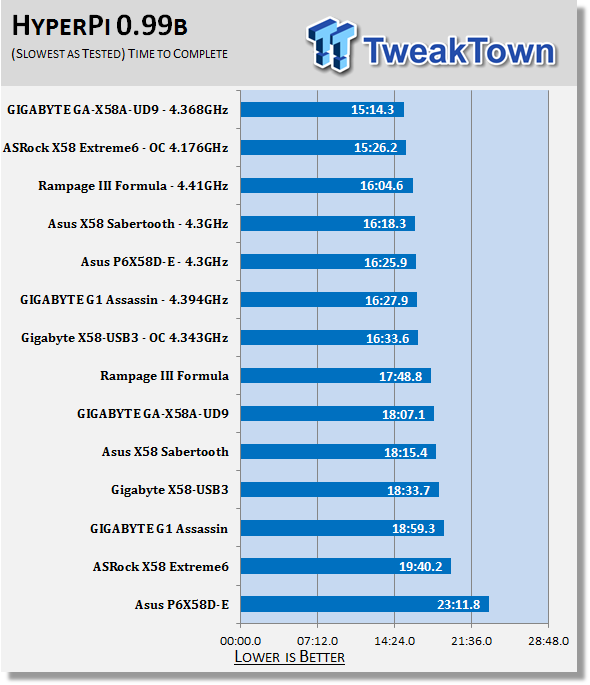
The X58-USB3 did much better than we expected here. We would expect to see some good HDD performance to balance out the lower than expected memory speed we saw above.
Synthetic Tests - Part II
Disk Drive Controller
The system drive controller is an important part of system performance. In most modern boards your drive controller will run off of the PCI-e bus. The PCI-e bus performance can be affected by poor trace layout as well as many other design choices that show up on different boards.
For testing we use Sisoft's Sandra and Everest.
SiSoft Sandra
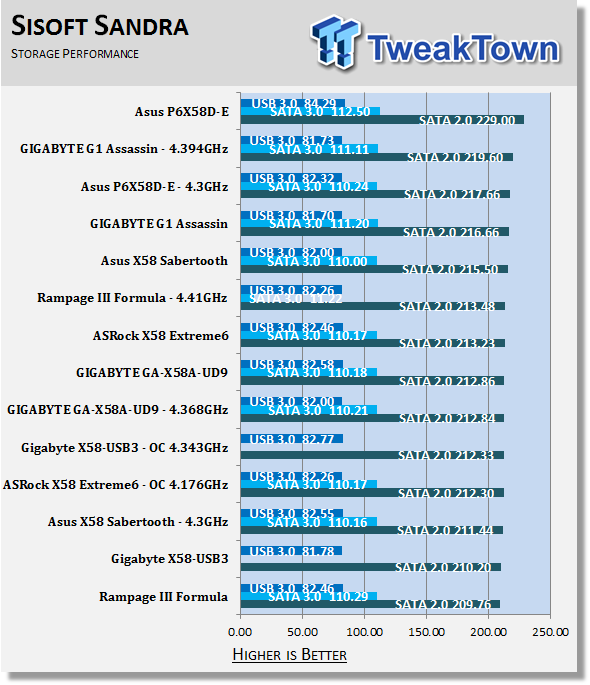
Hmmm, not sure what to think here. We saw low memory bandwidth, but fairly decent HyperPi scores. Normally we would expect to see good HDD performance to fill in the gap, but that is not the case here. Still, it is a good thing to see the higher number crunching scores.
AIDA64
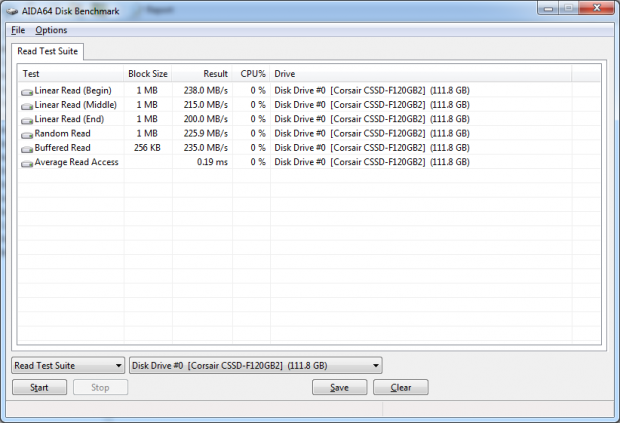
Stock HDD Performance
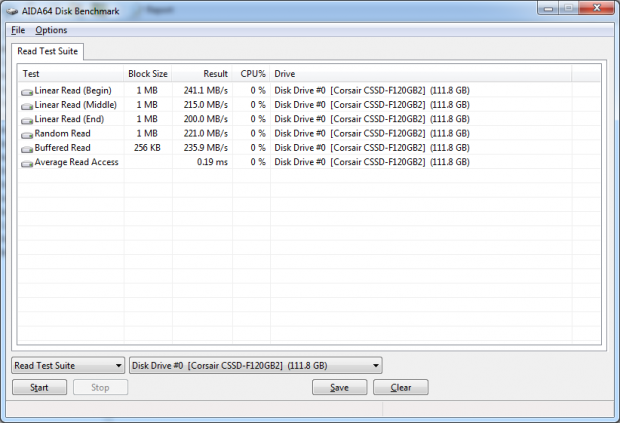
Overclocked HDD Performance
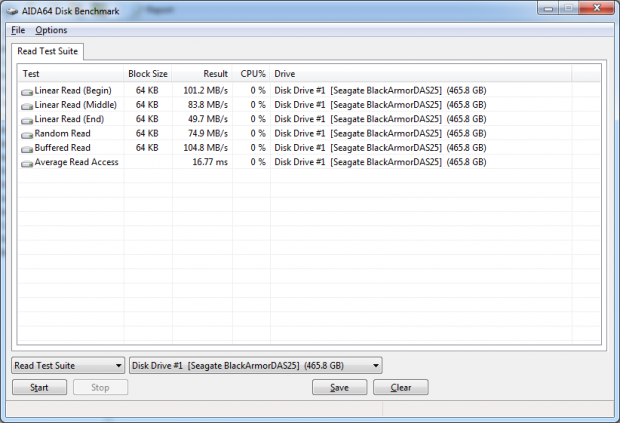
Stock USB 3.0 Performance
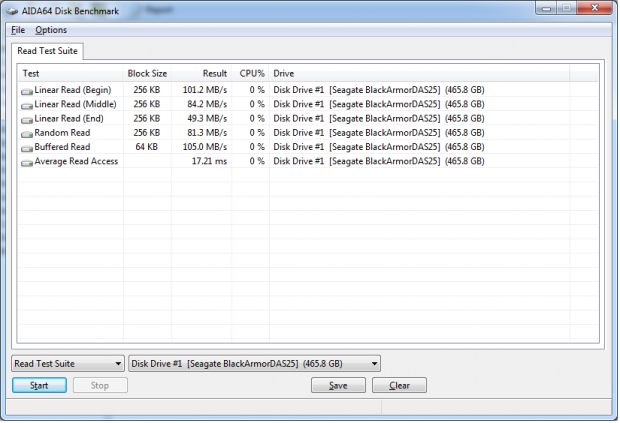
Overclocked USB 3.0 Performance
AIDA64 tells us the same story. The HDD performance is not where we would like to see it. It is not terrible, but we would like to see it better.
Synthetic Tests - Part III
Here is where we dig out the FutureMark tests.
PCMark Vantage
Version and / or Patch Used: 1.0.0.0
Developer Homepage: http://www.futuremark.com/
Product Homepage: www.futuremark.com
Buy It Here
For overall system performance we use PCMark Vantage. This is run in both x86 and x64 mode to give the best indication of performance.
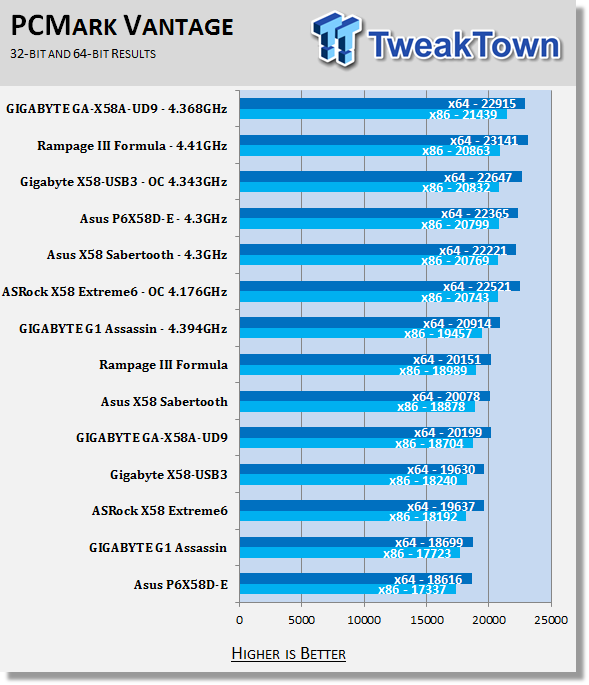
The PCMark Vantage performance at stock speeds was not inspiring, but it did catch up when we pushed the system.
3DMark 11
Version and / or Patch Used: 1.0.1
Developer Homepage: http://www.futuremark.com/
Product Homepage: http://www.3dmark.com
Buy It Here
For synthetic gaming tests we used the industry standard and overlockers bragging tool 3DMark 11. This is a test that strives to mimic the impact modern games have on a system. Futuremark went a long way to change from the early days of graphics driven tests to a broader approach including physics, AI and more advanced graphics simulations. 3DMark V11 uses the DX11 API in addition to having support for CPU based Physics. Gone are the days of the PhysX inclusion giving you inflated scores.
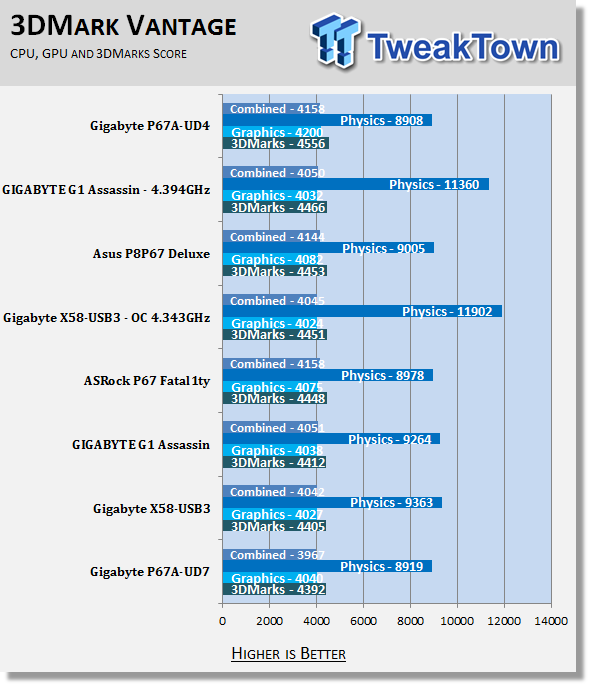
Although the numbers here are very close (much like real gaming), we can see a few places where each board distinguishes itself. The X58-USB3 pulls it off in the CPU based Physics scores, at least when overclocked.
Cinebench R11. x64
Version and / or Patch Used: R11.5 x64
Developer Homepage: http://www.maxon.net/
Product Homepage: www.maxon.net
Download It Here
Cinebench is a synthetic rendering tool developed by Maxon. Maxon is the same company that developed Cinema4D, another industry leading 3D Animation application. Cinebench R11.5 tests your systems ability to render across a single and multiple CPU cores. It also tests your systems ability to process OpenGL information.
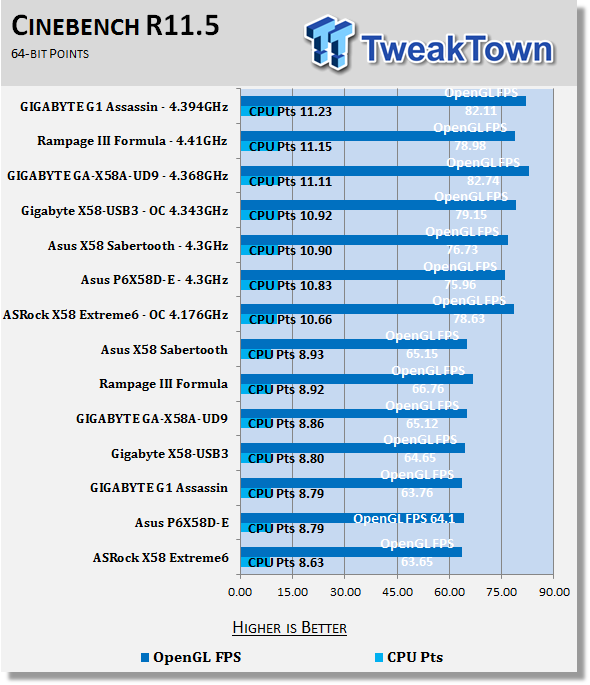
The CB-R11 scores are fairly close across the X58 line up. We do find the X58-USB3 towards the bottom of the pack at stock speeds, but really not by much.
Real-World Tests - Part I
Real-world testing allows us to see how well a product will perform when used in the same manner as it would be in your house or office. It is an important side to performance testing as it can uncover hidden glitches in the way a product performs.
It is especially true when testing a mainboard; there are so many components of a board that have to interact that any problems between parts can cause a failure of the whole.
For real-world testing we use some common applications and functions. We test with LightWave 3D for rendering performance, AutoGK for transcoding from DVD to AVI and two games for gaming testing.
Rendering
Rendering of 3D Animation is a system intensive endeavor. You need a good CPU, memory and HDD speed to get good rendering times. For our testing we use LightWave 3D. This software from Newtek is an industry standard and has several pre-loaded scenes for us to use.
LightWave 3D
Version and / or Patch Used: 9.6
Developer Homepage: http://www.newtek.com
Product Homepage: http://www.newtek.com/lightwave/
Buy It Here
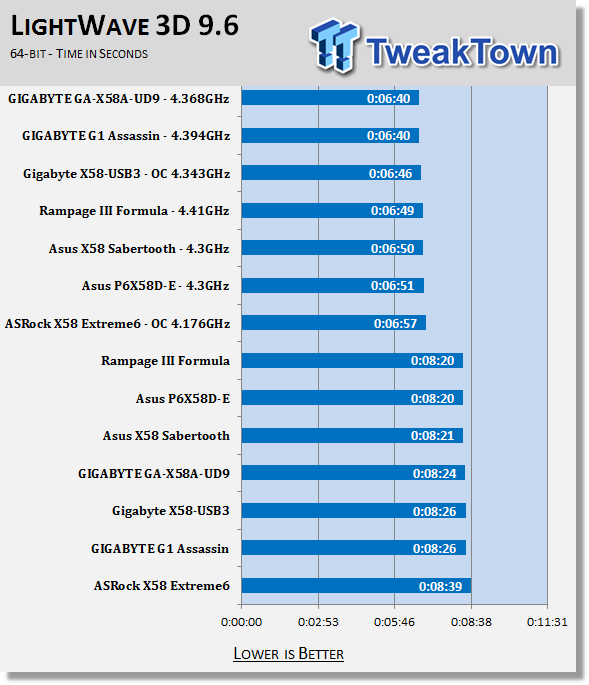
For LightWave 3D the X58-USB3 is right about where it should be.
AutoGK
Version and / or Patch Used: 2.55
Developer Homepage: http://www.autogk.me.uk/
Product Homepage: http://www.autogk.me.uk/
Download It Here
AutoGK stands for Auto Gordian Knot; it is a suite of transcoding tools that are compiled into an easy to install and use utility. It allows you to transcode non-protected DVDs and other media to Xvid or Divx format. For our testing purposes we use a non-DRM restricted movie that is roughly 2 hours in length. This is transcoded to a single Xvid AVI at 100% quality.
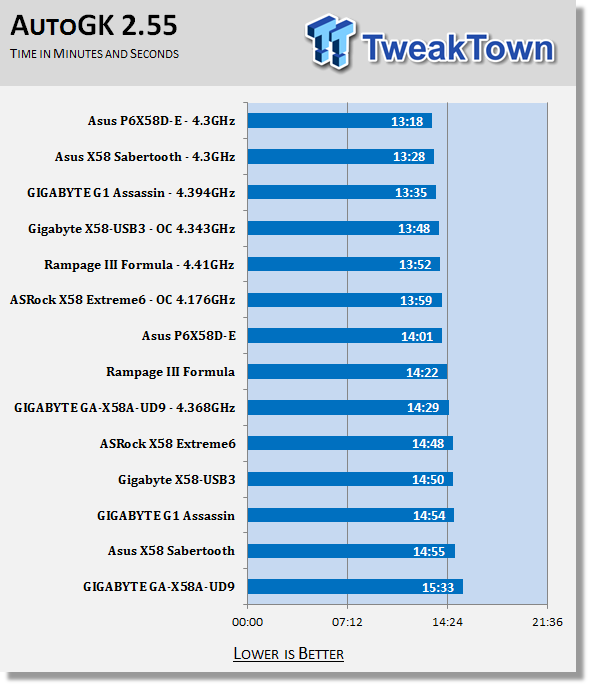
The times for transcoding our 2 hour test movie are also very close. The X58-USB3, while lower on the scale, still does well here.
Real-World Tests Part II
Here we have our real gaming tests. Each of the games we chose uses multiple cores and GPUs. They are able to stress the system through use of good AI. Both have decent positional audio that adds impact to the sound subsystem of the board. We ran each game through the level or parts listed and recorded frame per second using FRAPS. This brings the whole game into play.
*** A word on gaming as a motherboard test; ***
Despite the fact that most games are very GPU limited, we are still noticing HDD and even audio creating issues in gaming performance. Because of this you may see differences in the number of frames rendered per second between different boards. Usually the difference is very small but occasionally, because of bad tracing, poor memory or HDD performance this difference is significant. The issues are often more prevalent in older versions of DirectX but can still pop up in DX10 and 11.
Call of Duty Modern Warfare 2 (DX9)
Version and / or Patch Used: 1.0
Timedemo or Level Used: First combat until the school is cleared
Developer Homepage: http://www.infinityward.com
Product Homepage: http://modernwarfare2.infinityward.com
Most of you know about the game Modern Warfare 2; it caused quite a bit of controversy in the latter half of 2009. The game is a first person shooter with a heavy combat emphasis. It follows the events in the first Modern Warfare very closely and brings back several characters from the original.
As with most games in the Call of Duty franchise, it features a heavy AI load. This is not because of a complex AI routine, but more due to the sheer number of enemies in any given combat situation. It is also our single DX9 based game in our testing suite. Settings are shown below.
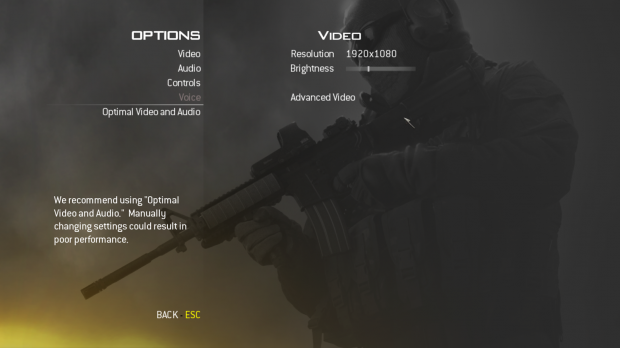
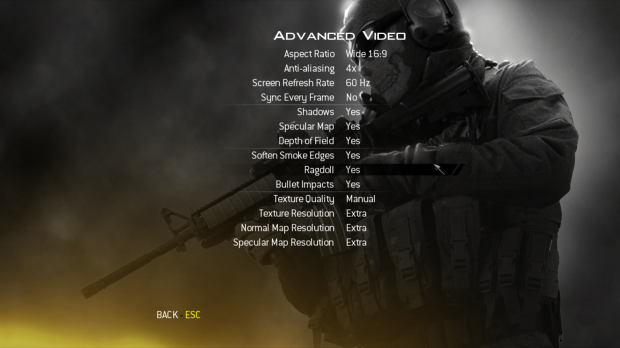
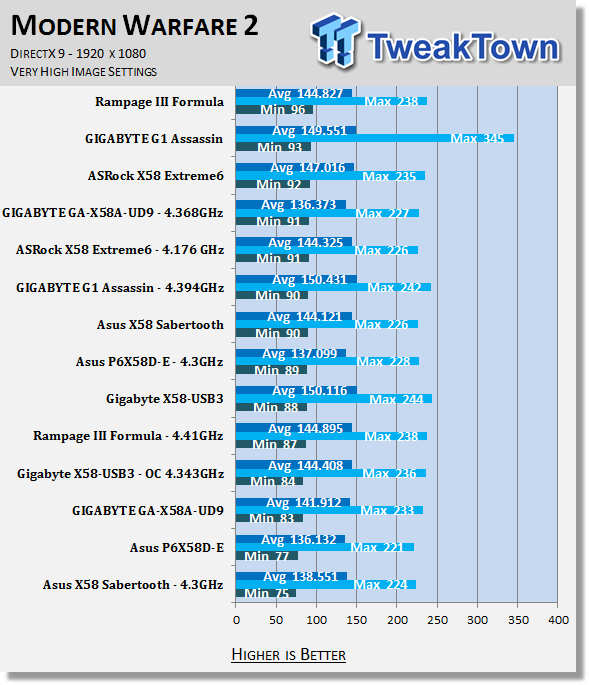
As a gaming platform the X58-USB3 does pretty well when it comes to Modern Warfare 2. It is able to handle the AI (which while simple, involves a large number of bots), the graphics and the audio. With this in mind, you should not have trouble running most DX9 games on this board.
Far Cry 2 (DX10)
Version and / or Patch Used: V1.00
Timedemo or Level Used: Clearing the Safe house through to the Rescue
Developer Homepage: http://www.ubi.com
Product Homepage: http://farcry.us.ubi.com
Far Cry 2 is a large sandbox style game. There are no levels here so as you move about the island you are on you do not have to wait for the "loading" sign to go away. It is mission driven so each mission is what you would normally think of as the next "level".
In the game you take the role of a mercenary who has been sent to kill the Jackal. Unfortunately your malaria kicks in and you end up being found by him. Long story short, you become the errand boy for a local militia leader and run all over the island doing his bidding. Settings we used for testing are shown below.
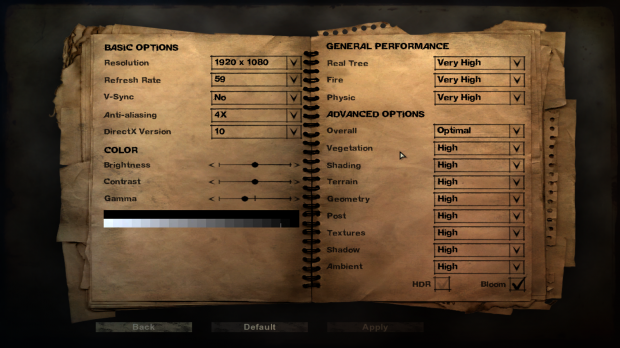
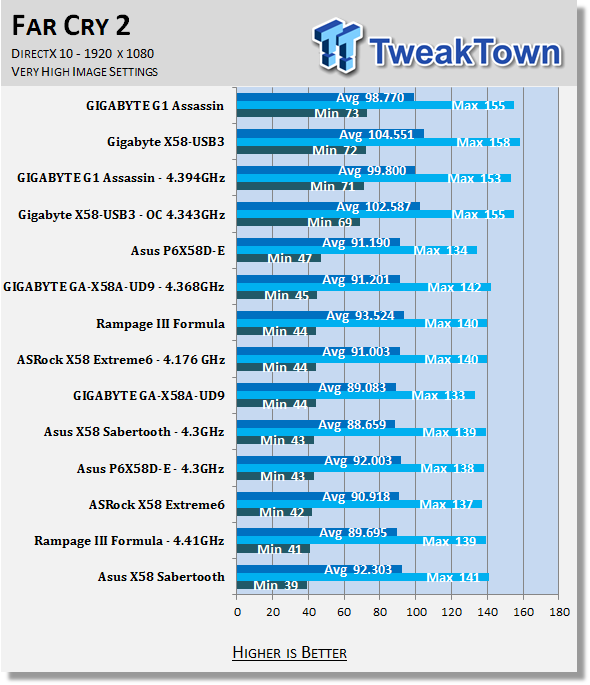
Far Cry 2 has an interesting metric going on here. For most of our testing the minimum FPS was in the mid to high 40s. However, the breakaway group kicks things off at 69FPS and heads upward. Most of these are overclocked systems, but both the G1.Assassin and the X58-USB3 are up here, too.
Battlefield Bad Company 2 (DX11)
Version and / or Patch Used: V1.00
Timedemo or Level Used: From washing up on the beach to the mine fields.
Developer Homepage: http://www.ea.com/
Product Homepage: http://badcompany2.ea.com/
Battlefield Bad Company is another sequel and also another game "franchise". Bad Company 2 is also our DX11 Shooter game. The game follows a fictitious B company team on a mission to recover a Japanese defector. This puts you back in World War II (at least for the beginning of the game) while the multi-player game is centered on much more modern combat. For our testing we used the single player mode. Settings are shown below.
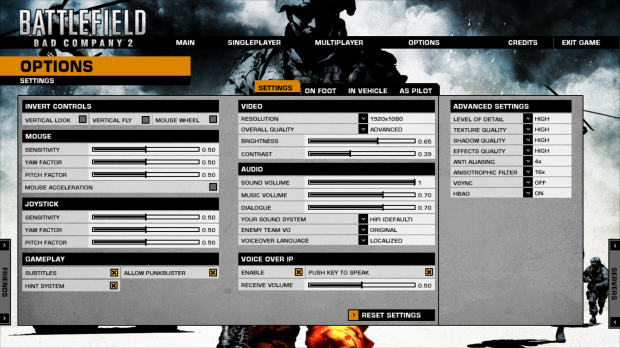
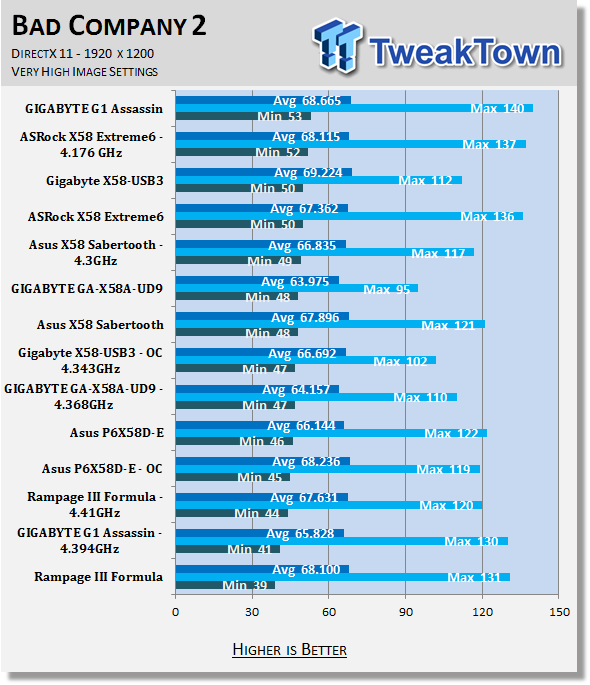
Although the range here is small, the X58-USB3 is very close to the top boards in our test group. This is pretty good considering the price point. Of course, a lot of this is the HD 5870 that we are using for testing, but it is nice to know that the board will not hold you back for Bad Company 2.
Gaming Conclusion
As far as gaming goes, you could do a lot worse than the GIGABYTE X58-USB3. Even in single card mode you get good frame rates. The audio and LAN performance is also more than acceptable.
Power Usage, Heat Tests and Final Thoughts
Power Consumption
We are now able to find out what kind of power is being used by our test system and the associated graphics cards installed. Keep in mind; it tests the complete system (minus LCD monitor, which is plugged directly into an AC wall socket).

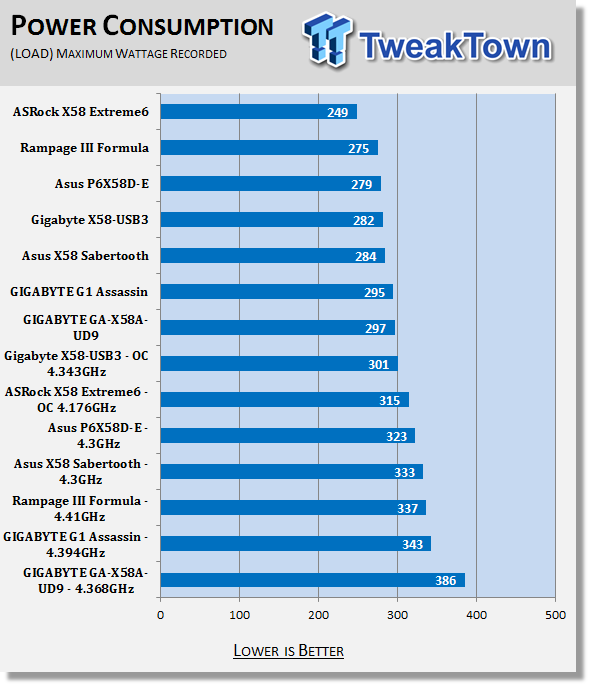
The X58-USB3 is not the most power efficient board we have tested, but it is up there at the top of the pack.
Heat Generation
As a new measure, we are now monitoring the heat generation from the key components on the motherboard; this being the Northbridge, Southbridge (if it contains one) as well as the Mosfets around the CPU. The results are recorded at idle and load during the power consumption tests.
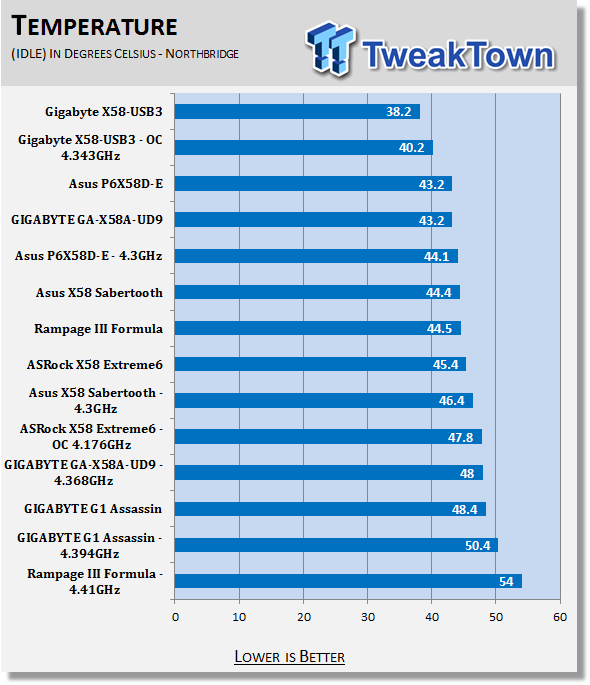
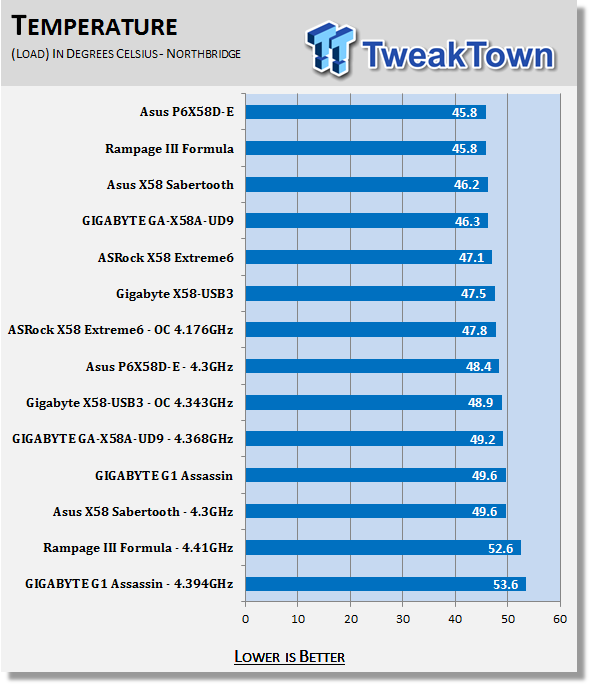
It looks like the combination of the beefy cooling and the light component density has an effect here. The idle temps are excellent and the load temps are not that bad either. Even overclocking does not saturate the cooling.
Final Thoughts
I have to say that I like the GIGABYTE X58-USB3. It is a quick little board with some surprises for anyone that picks it up. True, it lacks SATA3.0, but for many (indeed for most), that is not important just yet.
On top of the performance that you can expect, you will also save yourself some money. What you save (about $100) could be enough to get a better GPU, more memory, or that next speed bump of CPU. You really would not go wrong getting the X58-USB3 as a solid mid-range board. With a price tag of only $179.99 from NewEgg.com, it is certainly worth taking a look.

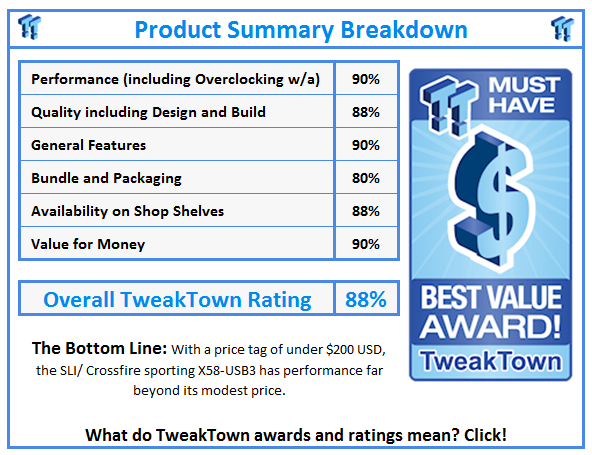
 United
States: Find other tech and computer products like this
over at
United
States: Find other tech and computer products like this
over at  United
Kingdom: Find other tech and computer products like this
over at
United
Kingdom: Find other tech and computer products like this
over at  Australia:
Find other tech and computer products like this over at
Australia:
Find other tech and computer products like this over at  Canada:
Find other tech and computer products like this over at
Canada:
Find other tech and computer products like this over at  Deutschland:
Finde andere Technik- und Computerprodukte wie dieses auf
Deutschland:
Finde andere Technik- und Computerprodukte wie dieses auf